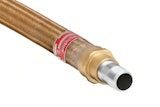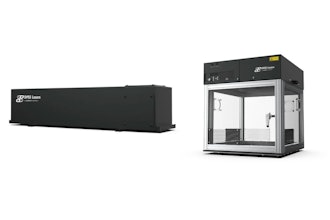Food processing is one of the largest manufacturing industries in the United States. NACE International, the world’s leading corrosion control organization, estimates that nearly $2.1 billion is spent annually on corrosion-related costs in the food industry. Keeping corrosion at bay is critical since it can lead to unacceptable contaminants in a food manufacturing environment that threaten sanitation and product safety, as well as reduce the reliability of machinery, leading to costly downtime. Corrosion is a threat to the overall success and profitability of any food manufacturing facility.
There are daily practices that make processing facilities a highly corrosive environment: the chemical properties of different foods, the use of water during processing and cleaning, and the use of chemicals during cleaning can all be very corrosive to metals used in processing facilities.
Many food products require the mixing of concentrated chemicals such as chlorides and organic acids, or treatment with agents such as sodium bisulfite, potassium bisulfite and sodium sulfite, all of which are highly corrosive to metals. Also, some foods are naturally more corrosive than others. Highly acidic foods with a 3-5 pH, such as citrus, jams, sauces, dressings and pickled vegetables, fall in the most corrosive class of foods in the processing industry.
Perhaps the most commonly used corrosive element used daily in processing plants is water. Steam heating, cooling and other processing and cooking procedures require continual use of water., Also, since facility cleanliness is a crucial part of food manufacturing, daily sanitization processes must be conducted to meet industry requirements, and large amounts of water are used in daily washdown procedures. Additionally, these sanitization processes often use chemical cleaning solutions that are corrosive to metals.
While the high exposure to water and other corrosive elements cannot be avoided, there are a number of ways to reduce the occurrence of corrosion in a facility. Many plants implement a maintenance management system to monitor machinery activity and identify potential danger to machinery at the root cause, after the damage begins to show signs and affect production. However, corrosion-prevention plans can often be more effective than corrosion-treatment, enabling facility operators to avoid costly repair and downtime that could result even from a minor amount of corrosion. Prevention methods include strategic facility design, selection of proper materials and the use of protective coatings.
When designing a facility for adequate corrosion protection, surfaces should be smooth, without ridges and crevices that can collect organic matter. There should be minimal projections and recesses, and all components should be welded together or continuously bonded to create solid surfaces. Pipes and vessels should be designed with curves at a radius that allows for easy cleaning and complete drainage in order to prevent fluid retention after cleaning. Facilities and equipment should be ready for easy and thorough washdowns, where all organic matter can be easily washed away while allowing cleaning fluids and water to drain completely.
Material selection is another crucial factor in designing a corrosion-resistant facility. Materials chosen should be able to withstand exposure to corrosive elements during daily sanitization procedures, as well as exposure to the chemical properties of food products. For example, aluminum should not be used in environments where mineral acids are used, and stainless steel should not be used in salt or chlorine environments.
Protective coatings prevent the chemical action of corrosion by blocking electrolytes from the anode, cathode and metallic path, which are often on the same piece of material. Metallic coatings are applied to change the surface properties of another metal, creating a new composite material that exhibits properties not achieved by either material alone. Steel is often galvanized—a process of coating carbon steel with zinc during a hot-dip process—which provides a degree of corrosion-resistance. In severely corrosive environments, galvanized steel is often coated with an additional paint or polymer coating, such as PVC, for even stronger corrosion protection.
However, if a surface is improperly prepared, the adhesion of other coatings such as PVC can fail and corrosion is actually accelerated due to the fact that corrosive elements are now trapped under the coating and held against the metal substrate. Some brands of PVC-coated galvanized rigid metal conduit have been successfully used in corrosive environments for decades due to the proper surface preparation and adhesion of PVC to steel. Corrosion College, an accredited two-day educational program that provides knowledge on beating corrosion in many industries, emphasizes that proper surface preparation is essential to ensure reliable coating protection.
After attending a course at Corrosion College, facility operators at a beef processing plant were well informed about the various factors that contribute to corrosion, as well as the important requirements for a successful corrosion-prevention plan. The electrical group was able to put their knowledge toward solving costly corrosion problems in the plant immediately. Prior to the course, the electrical maintenance crew had been applying a layer of paint to metal housings on the lighting system. Their effort to prevent corrosion was only a short-term solution that resulted in peeling paint that threatened to contaminate the food production line. The group learned that replacing the housings with a properly coated metal material would enable the electrical system to withstand the chemical properties in the environment, and that this investment would save the company hundreds of thousands of dollars.
The group was also able to solve a problem of corroded conduit where wires had been exposed due to severe corrosion. The Corrosion College attendees learned that the corrosion, in this case, was the result of two different metals having contact with one another, and the crew was able to correct the issue by properly protecting each material and preventing contact. With knowledge gained at Corrosion College, the group was able to develop a long term plan for preventing corrosion damage and avoiding costly downtime.
Food manufacturing facilities are highly corrosive environments due to the continual exposure to chemicals, water and other corrosive elements used during processing and daily sanitization. It is critical to prevent corrosion in order to avoid the high costs of equipment repair, replacement and downtime that is often the result of corrosion damage. Preventative measures, such as proper facility design and the use of materials with properly applied protective coatings, can drastically reduce the threat of corrosion damage. Corrosion College is a valuable resource offering knowledge to support the long term success of processing facilities in the food manufacturing industry.
About the author
Stephanie Ellis is director of Corrosion College. She holds NACE certification as a Corrosion Technician and is a member of the International Association of Electrical Inspectors. Corrosion College is a hands-on course that explains the process of corrosion through intensive instruction by professionals in the field of corrosion protection.























